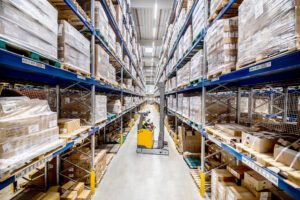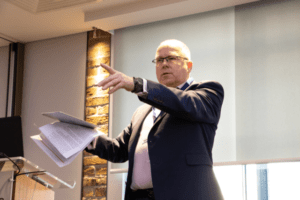In the second of three articles examining the elements that make up L’Oréal’s award-winning health and safety system we delve into how the company strives for OSH excellence through its standard setting, and behavioural and cultural programmes.
In the previous article, we explained the risk assessment processes and safety rules implemented by L’Oréal to ensure optimal working conditions for its teams. Building on these processes, the group has developed a series of programmes and standards aimed at achieving excellence in health and safety and that are applicable to all of its sites worldwide. These initiatives serve as an intermediary step in its “Risk assessment, excellence, and beyond” model.
To achieve this state of excellence, L’Oréal implements a unified set of baseline safety controls globally, often surpassing the regulatory standards in the countries where it manufactures or distributes its products. These controls are derived from whichever regime the company has identified as having the highest level of protection. So, to regulate major accident hazards associated with the use and storage of large volumes of chemicals, its framework follows the European Union’s Seveso Directive, which was translated into UK law as Control of Major Accident Hazards Regulations 2015. Minimum fire safety standards are based on the code of the US National Fire Protection Association (NFPA).
These minimum standards are codified and enforced across all sites, irrespective of their location. Consequently, provisions in offices, laboratories, and warehouses in certain countries exceed the requirements set by local regulations. A notable example is the construction of a new plant in Sao Paulo, Brazil. In addition to complying with the fire extinguishing system mandated by local authorities, the group implemented its own standards, following the guidelines of the NFPA code. This involved constructing a bunker – an isolated room equipped with its own automated fire extinguishing system – specifically designed for storing substances like ethanol, which are used in products such as sun protection.
Visible Felt leadership and Employee engagement

Forkflit in the L’Oréal Mönchengladbach Distribution Center in Germany. CREDIT: L’Oréal
Similar to numerous well-developed health and safety systems, L’Oréal relies on information and prevention campaigns targeted at its teams.
These behavioural programmes include MESUR (Measuring Effectively Safety Using Recognition), a programme designed for managers. Regular MESUR inspections are conducted by managers for their respective teams. These inspections involve open-ended questions about the work environment, prevention, and potential safety enhancements. Such a programme also fosters trust building between teams and their managers, as they reflect collaboratively on safety and preventive measures. The actions resulting from these discussions are then implemented by the managers, who subsequently inform their team members.
The Group has also implemented “Visible Fundamentals” for operational staff. These concise guides offer an evaluation of potential risks associated with each task. They are developed by teams and their supervisors and should be consulted before performing any task. This evaluation is further reinforced by “Take 2,” an informal process of dynamic risk assessment that encourages teams to take a moment before commencing a task to assess working conditions and determine if they can carry it out safely, considering their attentiveness, skills, and appropriate use of personal protective equipment (PPE). If the necessary conditions for performing the task safely are not met, teams should refrain from proceeding until they have informed their manager and discussed the situation with them
An online suggestion scheme, Safety Improvement Opportunity (SIO) lets employees submit ideas for safety enhancements any time. Line managers provide local feedback on suggestions and site managers review all SIO forms to identify those that would be useful to other sites and parts of the business. The expectation is that more than 90% of SIOs will be closed out within 12 months, to maintain confidence in the system and management credibility.
Culture building
The behavioural programmes help L’Oréal develop a strong safety culture, but it also underpins them with culture-specific programmes. The group has implemented a procedure to be followed in case of a potential incident, incorporating investigations to comprehend the underlying causes. In the event of an incident, occupational health and safety specialists, called in by a line manager, will conduct interviews with individuals involved and analyse the conditions and actions that might have contributed to it.
After any incident or near-miss judged to have been potentially severe, a Safety Accident Communication (SAC) must be distributed, providing concise details of the event, the lessons learned, and the actions to be taken by sites within the division to prevent a recurrence. These recommendations will be integrated into site safety and health action plans. SACs that have broader relevance will be distributed throughout the entire group.
Ergonomic Attitude is a programme designed to eradicate work-related musculoskeletal problems and promote good posture. The programme is overseen by a steering committee that establishes yearly targets for reducing potential musculoskeletal disorders and eliminating poor posture. Staff are encouraged to follow a schedule of warm-up and stretching exercises before work and offered advice on fitness and exercise.
“It really has been a game changer when it comes to employee involvement and developing site culture,” Staves says of the initiative. “It was designed for employees to help them design their workstations and introduce them to the basics of ergonomics. This a powerful combination that has an impact both at work and outside work.”
Ahead of the curve
The state of the safety culture is assessed through risk and culture audits carried out three-yearly at manufacturing plants and four-yearly at distribution centres, research facilities and administrative offices. The culture audits evaluate the level of the site’s EHS culture, including the quality of leadership and reassess its place on the culture maturity curve.
The risk assessment, excellence and beyond trajectory is overlaid on a modified version of the Bradley Curve model of health and safety maturity, in which the culture starts in a reactive state, with OSH managers taking responsibility for keeping people safe, then grows to the point where line managers take on safety duties, then into an independent phase in which employees take responsibility for their own safety. The desired end-state is mature interdependence when employees are passionate about working safely and want to ensure the safety of their colleagues as well as themselves.
Staves says that as more of the company’s sites reaches the mature end of the curve, the conversation about the value of safety changes from one about the cost of accidents or the value of safety to organizational efficiency to one that is more about human capital. “Eventually it becomes about putting your people at the centre and doing what’s right for them because that’s also right for the organisation,” he observes.
This people-centred approach is critical to the “beyond” component of L’Oréal’s “Risk assessment, excellence, and beyond” schema.

L’Oréal Global VP Health and Safety Malcolm Staves
Next time…
In the concluding article we will look at that strand, the programmes that help drive a generative safety culture and embed OSH in a human capital approach towards employees. The suite of articles summarises the content of a white paper, L’Oréal, A world-class safety system, which you can download here. You can also read the first article in this series here.
“We are hoping that through this series of articles we will be able to give other OSH professionals ideas of what they can do or change in their organisations,” Evidently, one size never fits all, but by sharing what we do and our experience maybe we can help another company save lives.” Malcolm Staves
The Safety Conversation Podcast: Listen now!
The Safety Conversation with SHP (previously the Safety and Health Podcast) aims to bring you the latest news, insights and legislation updates in the form of interviews, discussions and panel debates from leading figures within the profession.
Find us on Apple Podcasts, Spotify and Google Podcasts, subscribe and join the conversation today!



